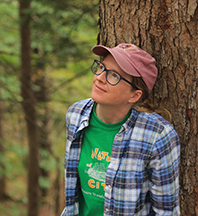Week of December 1, 2024 – December 7, 2024
by Anna Stunkel, Environmental Educator
When you drive through the Montezuma Wildlife Drive, partway down there is a massive dead tree snag where birds often perch. Almost every time that I pass it I see at least one bird sitting there– an Osprey eating a fish, a Bald Eagle taking a rest, a Red-tailed Hawk waiting for prey to scurry by, or a small group of swallows chattering. Although this tree is no longer living, it provides a perch for countless birds, especially since there is such an expansive view from that spot. Nature is resourceful in this way; even when a tree is no longer living, it provides a home for the surrounding community.
As the weather becomes chillier, many dead trees play the crucial role of shelter for birds and other critters like flying squirrels and bats. Woodpeckers and owls use tree cavities not only for nesting, but also as safe places to sleep, especially during stormy and cold weather. Woodpeckers often create new cavities for roosting that are separate from their nesting cavities, and some birds will cozy up in groups together to stay warm in their roosts. In particular, bluebirds, nuthatches, and wrens have been observed roosting in quite large groups. In one instance, 46 Winter Wrens were seen piling into the same tree cavity!
We can learn from creatures that make their homes in both living and dead trees. In nature, no space is wasted in the community. Animals often find innovative ways to take shelter and to stay warm by sharing roosting space. After a woodpecker excavates a tree cavity and is no longer using it, other animals often move in. We can also help each other by sharing resources as the weather becomes wintry. This could be by shoveling a neighbor’s driveway, sharing a kind word, or bringing a friend or family member a warm meal.
To help resourceful critters, we can leave dead trees standing when it is safe to do so. Their soft wood is often an easier surface in which to excavate cavities, and tall dead snags are good vantage points for hunting birds. Next time you’re out and about on a cold or snowy day, take a look at dead trees for signs of life. Perhaps you’ll spot a woodpecker peeking out of a tree cavity or a Red-tailed Hawk waiting for a vole to run by.


